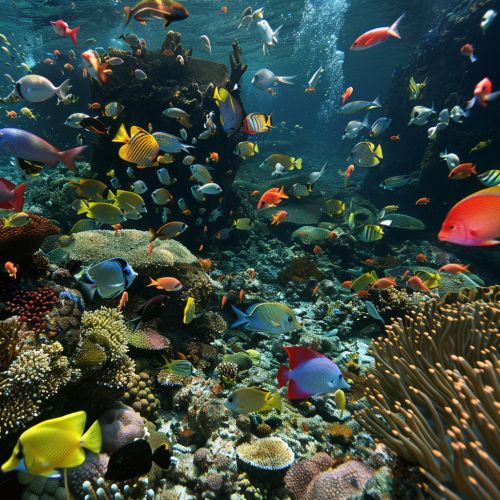Pelagic zone
Overview
The Pelagic zone is the part of the open sea or ocean that is not near the coast or sea floor. It is an area characterized by the vastness of open water and the lack of physical boundaries. The pelagic zone is further divided into different layers or zones based on depth, each with its unique characteristics and marine life.
Classification
The pelagic zone is typically divided into five main layers or zones. These zones are classified based on their depth from the surface of the ocean to the ocean floor. They are the Epipelagic, Mesopelagic, Bathypelagic, Abyssopelagic, and Hadalpelagic zones.
Epipelagic Zone
The Epipelagic zone, also known as the sunlight zone, extends from the surface to a depth of about 200 meters. This is the zone where most of the visible light exists, allowing photosynthesis to occur and supporting a diverse array of marine life.
Mesopelagic Zone
The Mesopelagic zone, also known as the twilight zone, ranges from 200 to 1,000 meters below the surface. Light in this zone is very faint, making it a challenging environment for organisms.
Bathypelagic Zone
The Bathypelagic zone, also known as the midnight zone, extends from 1,000 to 4,000 meters. No light penetrates this deep, and the pressure is immense, making it a harsh environment for life.
Abyssopelagic Zone
The Abyssopelagic zone, or the abyss, ranges from 4,000 to 6,000 meters. The temperature here is near freezing, and there is no light, making it a very inhospitable environment.
Hadalpelagic Zone
The Hadalpelagic zone is the deepest part of the ocean, ranging from 6,000 to 11,000 meters. This zone is found in deep sea trenches and canyons.


Marine Life
The pelagic zone is home to a wide variety of marine life. The type and abundance of life in this zone vary greatly with depth, with the most biodiversity found in the uppermost Epipelagic zone.
Epipelagic Marine Life
The Epipelagic zone is home to a wide variety of marine life, including various species of sharks, dolphins, and whales. This zone also supports vast schools of pelagic fish such as tuna and mackerel.
Mesopelagic Marine Life
The Mesopelagic zone is home to species adapted to live in low light and high-pressure conditions. These include bioluminescent organisms like the lanternfish, and the giant squid.
Bathypelagic Marine Life
The Bathypelagic zone is home to a variety of unique and strange creatures such as the fangtooth fish, gulper eel, and giant squid.
Abyssopelagic and Hadalpelagic Marine Life
The Abyssopelagic and Hadalpelagic zones are home to a limited number of species due to the extreme conditions. Organisms in these zones are highly adapted to high pressure, low temperature, and complete darkness.
Human Impact
Despite its vastness and depth, the pelagic zone is not immune to human impact. Overfishing, pollution, and climate change are some of the significant threats to the health and biodiversity of this zone.
